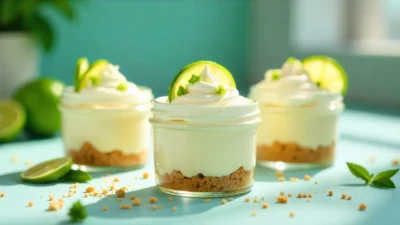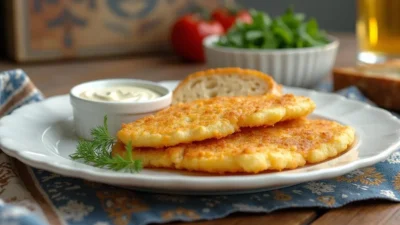Contents
If you’ve ever wandered into a small, sunlit Asian bakery just as the morning light spills onto the street, you know the magic that hits you first — that warm, comforting aroma of butter, sugar, and a hint of vanilla dancing in the air. It’s the kind of smell that wraps around you like a soft blanket, making you feel instantly at home. Among rows of glossy buns, flaky pastries, and tiny tarts, there’s always one humble little star that somehow steals your attention without even trying: the Chinese mini sponge cake 🧁
These cakes don’t rely on swirls of frosting or flashy decorations. Their charm is subtle, almost shy — a pale golden sponge rising gently in its paper sleeve, delicate enough that it almost quivers when you pick it up. Yet that very softness is what makes them unforgettable. One bite, and it’s as if time slows down for a moment; the texture melts on your tongue, the sweetness whispers rather than shouts, and you can’t help but smile.
They are simple. They are comforting. They are nostalgic. And the best part? You don’t have to be a professional baker to create them — with a little care and patience, you can bring that same magic right into your own kitchen ☁️
🧭 A Bite of History
The story of these little golden clouds begins in the bustling bakeries of old Hong Kong, where East met West in a delicious collision of flavors and techniques. British sponge cakes had made their way into the city, and local bakers, ever resourceful, began to make them their own. They reduced the sugar to suit local tastes, swapped butter for oil to keep the cakes moist and light, and transformed them into charming single-serving portions, perfect for a quick snack or an accompaniment to tea.
The outcome? A cake that became more than just a treat — it became part of the city’s heartbeat. ☕ Morning commuters would pick one up on the way to work, pairing it with a warm cup of milk tea, enjoying a quiet, comforting moment before the day began. Over the years, these paper-wrapped sponges rose to iconic status, quietly claiming their place as a symbol of Hong Kong’s dessert culture — modest, unassuming, but deeply beloved.
As the recipe traveled across Asia, it evolved gracefully. In Malaysia, bakers might add a hint of coconut; in Taiwan, a sprinkle of citrus zest brightens the flavor; in Japan, a touch of matcha introduces a soft green hue and earthy aroma. Yet no matter where these cakes go, they carry the same essence — a gentle sweetness and a cloud-like texture that lingers in your memory, like a quiet, joyful whisper from the past.
✨ What Makes Them So Special
Let’s be honest: there’s something magical about a cake that’s almost lighter than air.
The first bite melts away before you can even describe it — just a trace of vanilla and egg, like a cloud kissed by the sun. Unlike cupcakes or muffins, which rely on butter and sugar for richness, Chinese mini cakes are all about balance. They’re soft but springy, moist but never greasy, sweet but never cloying.
Visually, they’re pure comfort — tall, golden, with the gentle curve of a rising sun. Wrapped in parchment, they look humble but elegant, like little gifts you unwrap slowly.
🍰 They’re the kind of dessert that makes people close their eyes after the first bite.
🧂 Simple Ingredients, Perfect Harmony
One of the things I love most about Chinese mini cakes is how deceptively simple they are. You don’t need fancy gadgets, exotic flours, or complicated flavorings — just a little patience, a gentle hand, and a handful of everyday ingredients you probably already have in your kitchen. And yet, from these humble components emerges something magical: a cake so soft it feels like a cloud in your hands ☁️
- 🥚 Eggs are the soul of the cake. The yolks bring warmth and richness, like a golden glow from the inside, while the whites, when whipped to perfection, lift the cake sky-high, creating that airy, dreamy texture that seems almost weightless.
- 🌾 Cake flour is the secret to tenderness. It’s lower in protein than all-purpose flour, which keeps the crumb delicate and soft. If all you have is all-purpose, don’t worry — just mix in a little cornstarch, and you’ll still get that light, melt-in-your-mouth feeling.
- 🍬 Sugar does more than sweeten. It stabilizes the whipped egg whites, helping your batter hold its airy structure, and contributes to the cake’s lightly caramelized top.
- 🥛 Milk adds moisture, softness, and that comforting, homey touch that makes the cake feel “right” from the first bite.
- 🫒 Oil keeps the sponge silky and tender, even a day or two after baking — unlike butter, it doesn’t firm up or dry out the crumb.
- 🌼 Vanilla extract is a little luxury. Just a drop transforms the batter with a warm, fragrant aroma that fills your kitchen like a gentle hug.
- 🍋 Cream of tartar or a few drops of lemon juice? Tiny, almost invisible helpers that give the meringue strength and lift. Without them, the airy peaks wouldn’t hold their shape, and that “cloud-like” magic would be lost.
It’s honestly fascinating how something so ethereal and delicate can come from such ordinary, everyday ingredients. And yet, each one matters — every pinch, every splash, every gentle fold contributes to the final masterpiece.
👩🍳 The Art of Making Them
Making Chinese mini cakes is less about following steps mechanically and more about listening to your batter, paying attention to texture, rhythm, and touch. It’s like coaxing life into a delicate little creature — every fold, every whisk, every moment counts.
Here’s how I like to guide them into existence:
- Prepare the molds. Start by lining your tins with tall paper sleeves or parchment cups that extend above the rim. The extra height gives your cakes space to rise gracefully, creating that signature puffed-up shape. Think of it as giving them a little scaffolding to stretch and shine.
- Create the yolk base. Whisk together egg yolks, milk, oil, vanilla, and half the sugar until the mixture is silky, pale, and inviting. Sift in the cake flour and fold gently — slow, careful movements are key. Rushing here can flatten the batter and lose precious air.
- Whip the egg whites. In a clean, dry bowl, beat them until foamy, then add cream of tartar. Gradually sprinkle in the remaining sugar, and continue beating until you see glossy, stiff peaks. When you lift the whisk, they should hold their shape, proud and shiny, ready to lift your sponge to cloud-like heights.
- Fold with care. Begin by adding a spoonful of meringue to the yolk mixture to lighten it. Then fold in the rest gently, using slow, sweeping motions. You’re not stirring — you’re nurturing the air, keeping it intact so the cakes rise perfectly. Imagine tucking little bubbles into a soft, golden blanket.
- Bake. Spoon the batter into the prepared cups, filling each about three-quarters full. Place in a preheated oven at 350°F (175°C) and let them bake for 20–25 minutes. The tops should turn a warm golden color and bounce lightly when pressed — a sign they’re ready to meet the world.
- Cool sideways. Once out of the oven, gently lay each cake on its side to cool. It might feel counterintuitive, but this trick helps prevent the delicate sponge from collapsing, preserving that airy, lofty texture we all crave.
When the paper finally peels away, you’ll see the reward: soft, moist cakes dotted with tiny, even bubbles, the kind that practically melt in your mouth and leave you grinning like a kid. It’s a moment that makes all the care and patience worthwhile.
💡 Tips from the Heart
There’s a quiet rhythm in baking — the small gestures that seem insignificant but make all the difference. Every baker has their own little secrets, the things they’ve learned not from recipes, but from trial, error, and the quiet hum of the oven. Here are a few of mine, gathered over countless batches of soft, golden cakes 💛
🌤️ Bring your eggs to room temperature.
Cold eggs may seem fine, but they don’t whip up the same way. When they’re warm, they trap air more easily, creating a smoother, silkier batter that practically floats when baked. I like to take them out of the fridge at least half an hour before baking — by the time the oven is hot, the eggs are ready too.
💨 Fold, don’t stir.
Think of folding as breathing life into your batter. Stirring too roughly knocks out the air bubbles you worked so hard to create. Use a spatula, turn the bowl gently, and move with care — like you’re tucking clouds into a blanket of sunshine.
🚫 Don’t peek.
I know it’s hard — waiting in front of the oven window is its own kind of torture 😅 But patience pays off. Opening the door too soon lets the heat escape and your little cakes might sigh and collapse. Trust the process. They’ll tell you when they’re ready: golden, fragrant, and puffed up with pride.
💦 Add a whisper of steam.
This is a little trick that bakery pros swear by. A small pan of hot water on the bottom rack keeps the oven air moist. That touch of humidity helps the tops stay smooth and prevents cracks. It’s like giving your cakes a gentle spa treatment while they rise.
⏳ Let them cool slowly.
It’s tempting to unwrap them right away, but patience here is pure magic. As they rest, the crumb sets, the flavor deepens, and the texture becomes that perfect in-between of airy and moist. I usually make a cup of tea while I wait — by the time I’m done sipping, they’re just right.
Tiny habits, big results. 💫 These small acts of care transform an ordinary bake into something unforgettable — a little softer, a little sweeter, a little more full of love.
🍊 Variations to Try
Once you’ve nailed the classic version, it’s time to have some fun 🎨
What I adore about these cakes is how adaptable they are. With a few tweaks, you can give them completely new personalities — playful, elegant, comforting, or bold.
- 🍵 Matcha Dream
Add a spoonful of matcha powder to the flour for a beautiful green hue and a delicate earthy flavor. It’s amazing with a drizzle of honey or a side of red bean paste. - 🍫 Chocolate Whisper
Sift in a tablespoon of cocoa powder and toss in a handful of mini chocolate chips. The result is like a cross between a cloud and a brownie — light, but deeply satisfying.
- 🍋 Citrus Glow
Grate fresh lemon or orange zest into the yolk mixture. The fragrance as it bakes is pure sunshine. - 🥥 Coconut Bliss
Swap some of the milk for coconut milk, then sprinkle a few toasted flakes on top. It tastes like a tropical vacation — soft, sweet, and creamy. - ☕ Espresso Kiss
Dissolve a pinch of instant coffee in warm milk before adding it in. The hint of bitterness makes the sweetness sing — perfect for afternoon coffee lovers.
No matter which path you take, the ending is always the same: golden paper peeling away, a soft sigh, and maybe a crumb or two left on the plate.
🍽️ How to Serve Them
There’s something almost ceremonial about serving these little cakes. Tradition says to present them just as they are — still nestled in their paper wraps. The pleasure lies in the act of peeling, feeling the warmth through your fingers, the gentle tug of parchment revealing the golden sponge beneath.
I like to serve them warm, with a pot of jasmine or milk tea ☕ The floral notes pair beautifully with the subtle sweetness of the cake. But they’re just as good cooled, maybe dusted with a whisper of powdered sugar or topped with a berry or two.
If you’re gifting them (and trust me, they make the sweetest presents 🎁), wrap each one in parchment, tie it with a bit of twine or ribbon, and slip it into a box with a small handwritten note. A little gesture like that feels timeless.
Of course, you can always go fancy — whipped cream, fruit compote, or even a drizzle of condensed milk — but honestly, they don’t need it. These cakes shine in their simplicity.
💭 Why People Still Love Them
Every culture has a dessert that feels like home, and for many, this is the one. There’s a kind of nostalgia baked into each crumb — memories of school mornings, the smell of a family bakery, or the comfort of sitting by the window with a warm cup of tea.
They’re not trying to impress; they simply exist to make you feel good. While modern pastries compete with frosting towers and edible glitter, these mini cakes whisper instead of shout. They remind us that beauty can be quiet — that warmth, patience, and simplicity still matter.
When the scent fills your kitchen, something shifts. The air feels gentler. The noise in your head quiets. And as you take the first bite, soft and golden, you remember that baking isn’t just about food — it’s about emotion. ❤️
🌸 Final Thoughts
Chinese mini cakes are more than just sweet treats; they’re small lessons in mindfulness. They ask you to slow down, to enjoy the whisking, folding, waiting — to breathe and be present.
They come out of the oven humble and warm, soft as a sigh, glowing like morning sunlight. And when you share them — with a friend, a neighbor, or just with yourself on a slow Sunday — they carry something deeper than sugar or flour.
So, grab your mixing bowl, crack a few eggs, and make a batch. Not because you need dessert, but because you deserve a quiet, beautiful moment that smells like home. ☁️🧁💛











